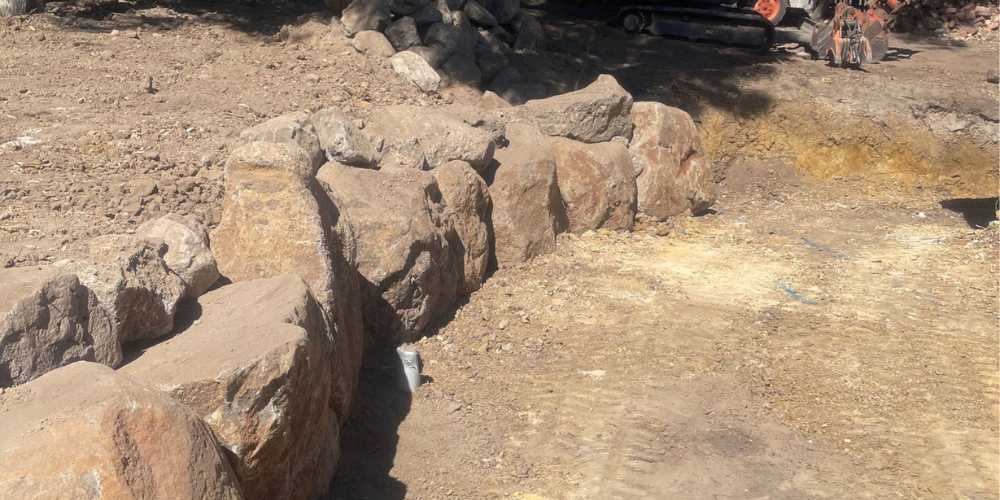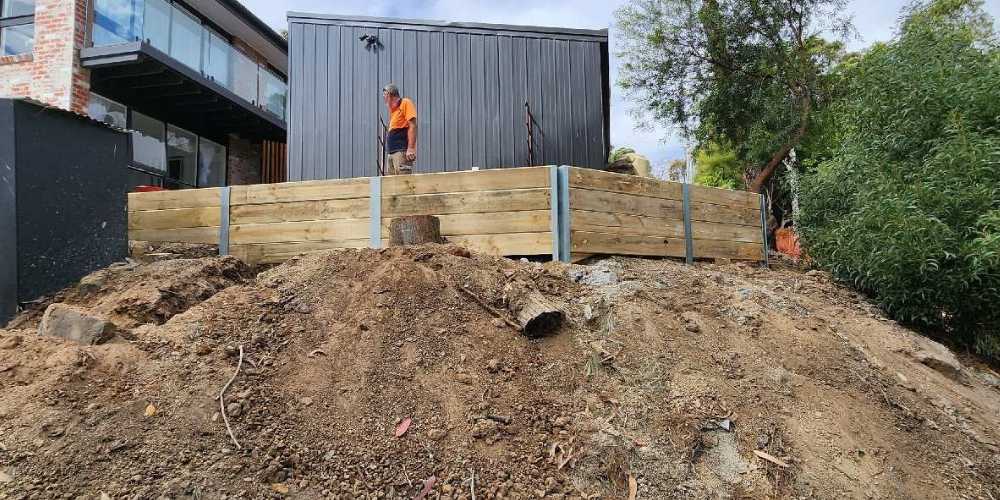How Much Does a Retaining Wall Cost?
Whether you’re a homeowner looking to improve the look of your property or a landscaping enthusiast planning a large outdoor project, you’re probably wondering, “How much does a retaining wall cost?”
Retaining walls are not only practical structures that offer necessary support to avoid soil erosion and control elevation changes; they can also be beautiful designs that enhance the visual appeal of any landscape. However, calculating the cost of building a retaining wall may be challenging, as it is affected by various factors ranging from materials and design complexity to labour and site conditions.
So how much of your budget should you prepare to achieve your dream property retaining wall? I am one of the trusted retaining wall builders in Melbourne so I have a fair share of information to share with you.
Let’s find out!

What's a Retaining Wall For?
A retaining wall keeps back and supports soil or other materials at various elevations. It is used in a variety of landscaping and civil engineering projects for a variety of objectives.
Retaining walls are very effective in:
Erosion Control
A retaining wall’s primary function is to prevent soil erosion on sloping terrain. Gravity may force dirt, rocks, or other objects to slide downhill when there is a large height difference between two parts of the ground. Retaining walls assist in stabilizing the soil and preventing erosion, so protecting the landscape from harm.
Grading and Terracing
On steep slopes, retaining walls are utilized to create terraced landscapes. It is feasible to create flat or moderately inclined areas for gardening, outdoor living spaces, or enhanced accessibility by erecting numerous walls at different levels.
Maximizing Usable Space
Retaining walls can create level areas or enhance useable space on properties with uneven terrain. They let homeowners convert sloping or steep landscapes into usable surfaces for gardens, patios, walks, and drives.
Sinkhole and Land Slide Prevention
Retaining walls can help stabilize the earth and avoid sinkholes in places with unstable soil or prone to landslides by holding back the dirt and stopping its movement.
Protecting Structures and Property
Retaining walls can be a protective barrier by keeping dirt away from houses, roadways, and other structures. This is especially crucial in places prone to floods or severe rains, when retaining walls may assist in regulating water flow and avoid damage.
How Much Does Retaining Wall Cost?
Evaluating the entire cost is one of the most important components of constructing a retaining wall for your property. The cost might vary greatly depending on various factors, including the materials used and the intricacy of the job.
We typically tell our client to budget $140 and $350 per square meter. Let’s look more closely at the individual materials usually used for retaining walls, each with its price range:
Treated Pine Retaining Wall:
Prices range between $250 and $350 per square meter.
Treated pine is a cost-effective option for smaller or less complex projects. While it has a good lifespan, remember that it may need additional care with time.
Treated Timber Sleepers or Hardwood Retaining Wall:
Prices range from $300 to $450 per square meter.
Timber sleepers and hardwood provide a natural and appealing appearance. They are more durable than treated pine and can endure various weather conditions, making them popular for residential and commercial applications.
Sandstone Block Retaining Wall:
Prices range from $300 to $550 per square meter.
Sandstone blocks have a more luxurious and visually attractive appearance, making them great for improving the beauty of your landscaping. The price varies based on the quality and location of the sandstone.
Retaining Wall Made of Reinforced Concrete Blocks:
Typically priced between $400 and $680 per square meter.
Reinforced concrete blocks are long-lasting and ideal for bigger or more complicated applications. Reinforcement adds strength and assures stability and lifespan.
Retaining Wall Made of Concrete Besser Blocks:
The price per square meter ranges from $550 to $700.
Besser blocks, concrete besser blocks or breeze blocks are a contemporary and adaptable retaining wall solution. They are noted for their durability and can be a cost-effective option for modern designs.
Overall, retaining walls can range in price from around $1,000 for small ones to over $10,000 for bigger ones.
Timber retaining wall cost less than other materials. However, its structural integrity and longevity are limited. Choose treated hardwood, concrete, brick, or stone for a longer lifespan. However, this will cost more overall, especially for the retaining walls made of concrete.

Factors Affecting Retaining Wall Cost
Several factors might impact the cost of constructing a retaining wall. Understanding these aspects is critical for effective budgeting and ensuring that your project’s financial resources are aligned.
Here are factors expected to always affect a retaining wall construction cost:
Materials
The selection of materials has a substantial impact on the final cost. The cost of various materials, such as wood, concrete blocks, natural stone, or brick, varies. For example, natural stone and concrete blocks are often more costly than wood.
Access
Building a retaining wall requires using tools, equipment, and building materials. If getting to the project site is problematic, your builder will need help getting everything they need there. Furthermore, your expenses will rise if your builder is compelled to transport the equipment and supplies by hand.
Height and Length of the Wall
The materials and workforce required for construction are directly proportional to the retaining wall’s height and length. Taller and longer walls necessitated using more resources, such as blocks or stones. They needed more labour to construct, resulting in higher pricing.
Site Situations
The condition of the construction site may influence costs. If the terrain is challenging to construct on, such as steep slopes or limited access, specialist equipment and experienced employees may be required, adding expenses.
Foundation Preparation
Proper site preparation ensures the retaining wall’s durability and lifespan. Excavation, levelling the land, and even constructing a sturdy foundation or base can all contribute to the overall cost.
Drainage System
It is essential to have an adequate drainage system to prevent water from pooling behind the wall, which might cause structural difficulties. The cost of installing drainage pipes, weep holes, or gravel backfill may increase.
Regulations and Permits
Building a retaining wall may need permission or authorization from local authorities in various regions. Obtaining these papers necessitates administrative costs and, in certain situations, engineering blueprints, which can add to the overall cost.
Labour Costs
The complexity of the wall’s design, the location of the building site, and the amount of experience of the builders all have an impact on labour expenses. Skilled work is essential for constructing a long-lasting and visually beautiful retaining wall, yet experienced specialists may be more expensive.
Tips for Hiring a Retaining Wall Builder
Hiring the appropriate retaining wall contractor is an important factor in the success and longevity of your project. Here are some helpful hints for locating a knowledgeable and dependable professional:
Gather Recommendations
Begin by investigating local retaining wall builders in your region. Request suggestions from friends, family, or neighbours based on their previous experiences. Online reviews and testimonials may also give useful information about a builder’s reputation and job quality.
Examine Credentials and Licensing
Make sure the builder is licensed, insured, and bonded. Valid credentials reflect that they have met all legal criteria and have the skills to manage their job effectively.
Review Previous Projects
Request a portfolio of past retaining wall projects from the builder. This will show you their craftsmanship, design talents, and material quality.
Request References
Request and follow up on recommendations from previous clients. Inquire with these clients about their experience dealing with the builder, the outcome of the project, and if they would recommend the builder to others.
Obtain Multiple Quotes
Get precise prices from various retaining wall contractors. Compare the quotations based on the materials, labour expenses, project timeframe, and any extra services provided. Choose a quotation that fits your budget and project specifications.
Inquire About Experience and Knowledge
Inquire about the builder’s previous expertise with retaining walls. An experienced builder has faced and conquered several obstacles and may provide important insight into your project.
Transparency and Communication
Check if the constructor is simple to reach and responds to your queries. Transparency in communication, including early discussion of anticipated obstacles and expenses, is critical for a successful working partnership.
Guarantee and Warranty
Inquire about the manufacturer’s warranty or guarantee. A trustworthy specialist will stand by their work and warranty materials and craftsmanship.
Understand the Contract
Before signing any contract, carefully read and comprehend it. Ensure that all project information, expenses, and timeframes are written down.
Avoid Lowball Offers
Be wary of extremely low bids since they might imply poor-quality materials or craftsmanship. Select a builder that delivers a reasonable and fair price based on industry standards.
Check for Permits
Permits may be required for retaining wall building, depending on local rules. A reputable builder will know these regulations and help you secure the relevant permissions.
Frequently Asked Questions
Building a small, low-level DIY retaining wall using minimal materials may be possible for people with construction skills and understanding. However, contacting a professional retaining wall builder for larger barriers or more complicated tasks is best. Experienced contractors can address site-specific problems while ensuring a visually beautiful, structurally solid outcome.
The amount of time it takes to build a retaining wall is determined by many factors, including the wall’s height, length, materials, site circumstances, and weather. Small retaining walls may take a few days to a week to finish, but bigger and more involved projects may take many weeks.
Yes, there are environmentally responsible choices for building retaining walls. Using environmentally friendly materials such as reclaimed bricks, wood, or concrete blocks can help to lessen environmental effects. Furthermore, good drainage systems assist in managing water more efficiently and reduce soil erosion.
A well-designed and professionally constructed retaining wall may improve your property’s utility and beauty. It can boost home value by increasing useable areas, creating tiered gardens, and increasing curb appeal.
Conclusion
A retaining wall may improve your environment by adding functionality, aesthetic appeal, and important soil support. Building a retaining wall varies depending on materials, height, site circumstances, and labour costs. Research and careful preparation are essential for a successful and cost-effective project.
Consider multiple retaining wall materials, get quotations, and use reputable and skilled contractors to build a long-lasting and visually appealing retaining wall that adds value to your property and survives the test of time.
Feel free to consult with local expert builders and use online resources to get knowledge and inspiration for your retaining wall project. Making wise choices will enable you to build an appealing, functional retaining wall that enhances the value of your home and makes the most of your outside area.

Share on facebook Facebook Share on twitter Twitter Share on linkedin LinkedIn Share on whatsapp WhatsApp Reading time: 7 min 39 sec Table of Contents Excavators are one of the most important pieces of equipment you can think of when it comes to any construction or landscaping project. Whether digging trenches, moving large amounts of

Share on facebook Facebook Share on twitter Twitter Share on linkedin LinkedIn Share on whatsapp WhatsApp Table of Contents Have you ever wondered how close a retaining wall can be to your house? Building a retaining wall is a fantastic way to manage soil and landscape your property. Still, getting the details right is crucial,

Reading time: 5 min 36 sec Share on facebook Facebook Share on twitter Twitter Share on linkedin LinkedIn Share on whatsapp WhatsApp Table of Contents If you’re here, you probably consider adding a retaining wall to your property. A well-built retaining wall can transform your landscape, prevent soil erosion, and add value to your home.
